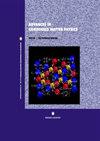Thermal Conductivity of Graphitic Carbon Nitride Nanotubes: A Molecular Dynamics Study
IF 1.8
4区 物理与天体物理
Q3 PHYSICS, CONDENSED MATTER
引用次数: 2
Abstract
Graphitic carbon nitride (g-C3N4) nanotubes are recently gaining increasing interest due to their extraordinary physicochemical properties. In the following, we report on simulations using a method of nonequilibrium molecular dynamics and focus on the thermal conductivity variation of g-C3N4 nanotubes with respect to different temperatures, diameters, and chiral angles. In spite of the variation of diameters and chiral angles, the structure of nanotubes possesses high stability in the temperature range from 200 K to 600 K. Although there is little change of the thermal conductivity per unit arc length for nanotubes with the same diameter at different temperatures, it decreases significantly with increasing diameters at the same temperature. The thermal conductivity at different chiral angles has little to do with how temperature changes. Simulation results show that the vibrational density of states of nanotubes distributed, respectively, at ∼11 THz and ∼32 THz, indicating that heat in nanotubes is mostly carried by phonons with frequencies lower than 10 THz.石墨氮化碳纳米管的热导率:分子动力学研究
石墨氮化碳(g-C3N4)纳米管由于其特殊的物理化学性质,近年来受到越来越多的关注。在下面,我们报告了使用非平衡分子动力学方法的模拟,并重点研究了g-C3N4纳米管在不同温度、直径和手性角下的导热系数变化。尽管纳米管的直径和手性角发生了变化,但在200 ~ 600 K的温度范围内,纳米管的结构具有很高的稳定性。相同直径的纳米管单位弧长热导率在不同温度下变化不大,但在相同温度下,随着直径的增大,单位弧长热导率显著降低。不同手性角下的热导率与温度的变化关系不大。模拟结果表明,纳米管态的振动密度分别分布在~ 11 THz和~ 32 THz,表明纳米管中的热量主要由频率低于10 THz的声子携带。
本文章由计算机程序翻译,如有差异,请以英文原文为准。
求助全文
约1分钟内获得全文
求助全文
来源期刊

Advances in Condensed Matter Physics
PHYSICS, CONDENSED MATTER-
CiteScore
2.30
自引率
0.00%
发文量
33
审稿时长
6-12 weeks
期刊介绍:
Advances in Condensed Matter Physics publishes articles on the experimental and theoretical study of the physics of materials in solid, liquid, amorphous, and exotic states. Papers consider the quantum, classical, and statistical mechanics of materials; their structure, dynamics, and phase transitions; and their magnetic, electronic, thermal, and optical properties.
Submission of original research, and focused review articles, is welcomed from researchers from across the entire condensed matter physics community.
 求助内容:
求助内容: 应助结果提醒方式:
应助结果提醒方式:


